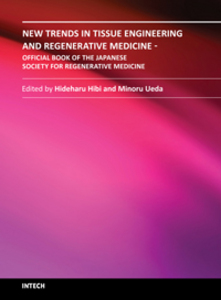Feasibility of molecularly targeted therapy for tooth regeneration
Takahashi, Katsu, Kiso, Honoka, Saito, Kazuyuki, Togo, Yumiko, Tsukamoto, Hiroko, Huang, Boyen, and Bessho, Kazuhisa (2014) Feasibility of molecularly targeted therapy for tooth regeneration. In: Hibi, Hideharu, and Ueda, Minoru, (eds.) New Trends in Tissue Engineering and Regenerative Medicine : official book of the Japanese Society for Regenerative Medicine. InTech, Rijeka, Coatia, pp. 55-66.
![[img]](https://researchonline.jcu.edu.au/35424/6.hassmallThumbnailVersion/3415.jpg)
|
Image (JPEG) (Book Cover)
- Published Version
Download (48kB) | Preview |
|
|
PDF (Published Version)
- Published Version
Available under License Creative Commons Attribution. Download (634kB) | Preview |
Abstract
[Extract] The tooth is a complex organ that consists of enamel, dentin, cementum, and pulp. Missing teeth is frequently occurring problem in aging populations. To treat these defects, the current approach involves prostheses, autotransplantation, and dental implants. The exploration of new strategies for tooth replacement has become a hot topic. Using the foundations of experimental embryology, developmental and molecular biology, tooth regeneration is becoming realistic possibility. Several different methods have been proposed to achieve biological tooth replacement. These include scaffold-based tooth regeneration, cell pellet engineering, stimulation of the formation of a third dentition, and gene-manipulated tooth regeneration. The idea that a third dentition might be locally induced to replace missing teeth is an attractive concept (Young et al., 2005; Edward & Mason, 2006; Takahashi et al., 2008, 2013). This approach is generally presented in terms of adding molecules to induce de novo tooth initiation in the mouth. Tooth development is the result of reciprocal and reiterative signaling between oral ectoderm-derived dental epithelium and cranial neural crest cell-derived dental mesenchyme under genetic control (Thesleff, 2006). More than 200 genes are known to be expressed during tooth development (http://bite-it.helsinki.fi/). A number of mouse mutants are now starting to provide some insights into the mechanisms of supernumerary tooth formation. Multiple supernumerary teeth may have genetic components in their etiology and partially represent the third dentition in humans. Such candidate molecules might be those that are involved in embryonic tooth induction, in successional tooth formation, or in the control of the number of teeth. This means that it may be possible to induce de novo tooth formation by the in situ repression or activation of a single candidate molecule. In this review, we provide an overview of the collective knowledge of tooth regeneration, especially regarding the control of the number of teeth for molecularly targeted therapy by the stimulation of a third dentition.
| Item ID: | 35424 |
|---|---|
| Item Type: | Book Chapter (Later Edition) |
| ISBN: | 978-953-51-1724-7 |
| Related URLs: | |
| Funders: | Grant-in-Aid for Scientific Research (C), A-STEP (Adaptable & Seamless Technology Transfer Program through Target-driven R&D FS stage |
| Projects and Grants: | Grant-in-Aid for Scientific Research (C) 22592213, Grant-in-Aid for Scientific Research (C) 25463081, A-STEP (Adaptable & Seamless Technology Transfer Program through Target-driven R&D) FS stage AS231Z01061G, A-STEP (Adaptable & Seamless Technology Transfer Program through Target-driven R&D) FS stage AS24Z02645Q |
| Date Deposited: | 08 Oct 2014 05:14 |
| FoR Codes: | 11 MEDICAL AND HEALTH SCIENCES > 1105 Dentistry > 110504 Oral and Maxillofacial Surgery @ 30% 11 MEDICAL AND HEALTH SCIENCES > 1105 Dentistry > 110507 Paedodontics @ 30% 10 TECHNOLOGY > 1004 Medical Biotechnology > 100404 Regenerative Medicine (incl Stem Cells and Tissue Engineering) @ 40% |
| SEO Codes: | 92 HEALTH > 9201 Clinical Health (Organs, Diseases and Abnormal Conditions) > 920113 Oro-Dental Disorders @ 100% |
| Downloads: |
Total: 2064 Last 12 Months: 18 |
| More Statistics |



